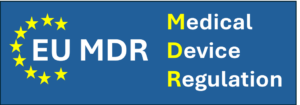MDR (Medical Device Regulation)

The Medical Device Regulation (MDR) 2017/745 is a regulation of the European Union that replaced the previous Medical Device Directive (MDD) and Active Implantable Medical Device Directive (AIMDD). It aims to improve the safety, quality, and transparency of medical devices marketed in the EU.
MDR became applicable on May 26, 2021, and establishes stricter criteria to ensure that medical devices are safe for users and effective for their intended purpose.
Importance of Compliance
Compliance with MDR is mandatory for any company wishing to market medical devices within the European Economic Area (EEA). MDR aims to improve patient safety by establishing comprehensive requirements for the design, testing, approval, and post-market surveillance of medical devices.
Non-compliance can lead to penalties, withdrawal from the market, or restrictions on selling products. Meeting MDR requirements is critical for maintaining market access and demonstrating that devices meet the required performance and safety standards.
Key Features of MDR
– Stricter Clinical Evidence: Manufacturers must provide more robust clinical evidence to prove safety and effectiveness, especially for Class II and III devices.
– Post-Market Surveillance (PMS): Continuous monitoring of devices is mandatory, and manufacturers are required to implement PMS systems to track product performance once in the market.
– Unique Device Identification (UDI): Devices need to have a UDI to enhance traceability throughout the supply chain.
– Classification Changes: Some devices previously classified as low-risk under MDD are now classified as higher risk, requiring additional regulatory scrutiny.
– EUDAMED Database: MDR introduces the EUDAMED database to ensure public access to information on devices, notified bodies, and certificates.
Scope of Application
MDR covers a broad range of medical devices, including surgical instruments, implants, diagnostic devices, software as a medical device (SaMD), and some aesthetic devices that may not have been covered under MDD.
Devices are divided into four risk classes: Class I (low risk), Class IIa (medium risk), Class IIb (medium to high risk), and Class III (high risk). Each classification determines the level of regulatory control.
Steps for Compliance
- Device Classification: Determine the risk classification of your device based on Annex VIII of the MDR.
- Quality Management System (QMS): Establish a QMS compliant with ISO 13485.
- Technical Documentation: Prepare a Technical File demonstrating device compliance with safety and performance requirements.
- Clinical Evaluation: Collect and provide clinical data to support the device’s safety and effectiveness.
- Conformity Assessment: Work with a Notified Body to conduct the conformity assessment and issue a CE certificate for high-risk devices.
- Registration in EUDAMED: Register the device and company in EUDAMED for transparency.
- Post-Market Activities: Develop and implement a Post-Market Surveillance (PMS) Plan and Periodic Safety Update Report (PSUR).
- Audits and inspections: Prepare your business on audits and inspections. Identify and correct potential discrepancies before the authorities visit.
Resources and Guidance
– MDR Full Text: Download the Official MDR Document
– Guidance Documents: Access guidance from the European Commission and the Medical Device Coordination Group (MDCG) for specific MDR-related topics
– Training Services: We offer MDR training programs to help organizations understand requirements and implement necessary changes to their procedures.
– Consulting: Contact our MDR Compliance Consulting Team to navigate the complexities of device classification, clinical evaluation, and technical documentation.
Latest Updates and News
Recent Updates: The European Commission extended the transition period for MDR compliance for certain medical devices until May 2024, allowing manufacturers additional time to meet new requirements.
Contact Information
For consultant help with MDR- compliance, email us at info@scengineering.dk or use the contact form.